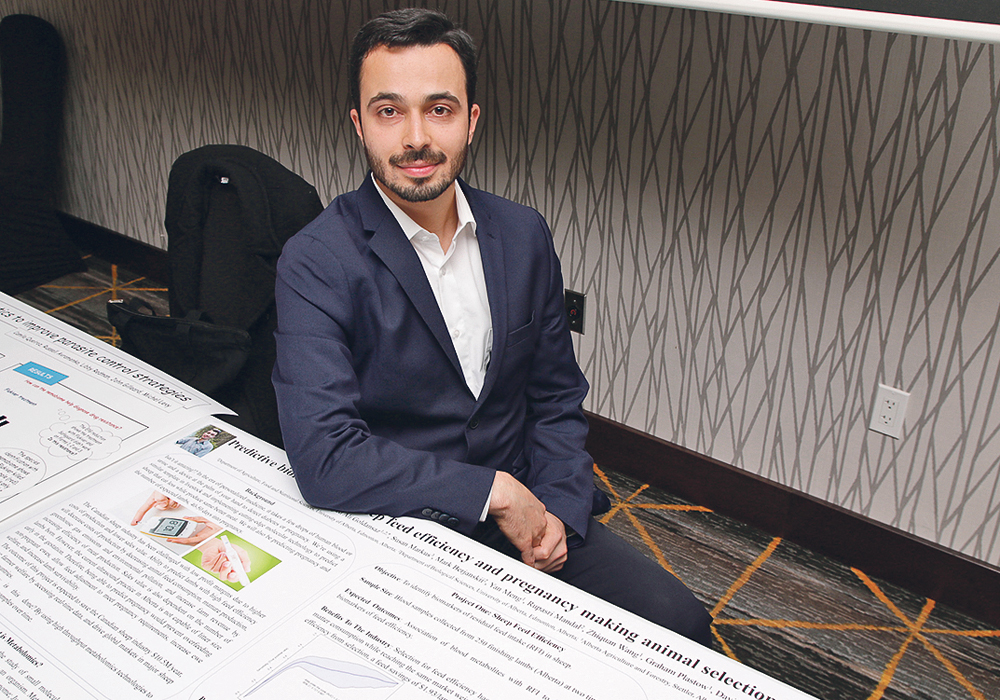Researchers say it would be a boon to the industry if producers could get accurate results from a simple blood test
RED DEER — Researchers associated with the University of Alberta hope to develop a device to help sheep producers detect pregnancy and feed efficiency in animals with only a few drops of blood.
The device is years away from being created and requires more research before it’s considered fool-proof, but preliminary results indicate it has strong potential.
“We don’t want to overpromise and underdeliver,” Seyed Ali Goldansaz, a research assistant with Livestock Gentec, an Alberta Innovates centre based at the university, said at the Alberta Sheep Breeders’ Association Symposium in Red Deer.
Read Also

Beef check-off collection system aligns across the country
A single and aligned check-off collection system based on where producers live makes the system equal said Chad Ross, Saskatchewan Cattle Association chair.
“We want to support the sheep industry in Alberta, as well as in Canada, and reach a stage where we reach an end product,” he said.
The device would stem from two separate projects being worked on by Livestock Gentec, the University of Alberta and the Metabolomics Innovation Centre.
The first project aims to figure out an animal’s feed efficiency score based on its blood sample.
The second project also uses an animal’s blood sample to determine if it’s pregnant and potentially the number of lambs it is carrying.
If scientists can effectively correlate blood samples with pregnancy and feed efficiency, then, Goldansaz said, they would move toward developing a device or mechanism that would allow producers to detect such characteristics.
He said preliminary results show that scientists are able to measure whether an animal is pregnant (anywhere from 30 to 50 days in gestation) and its feed efficiency with blood samples, but more work is needed until they can give it official approval.
If the projects pan out, Goldansaz said it would significantly help the sheep industry.
He said producers are always looking for solutions that could lower costs and improve efficiencies. Knowing their animal’s feed efficiency and pregnancy would do that.
“Animal feed consumption contributes up to 70 percent of all the cost of production, so any effort on saving on feed costs and feed resources would make a huge contribution to the enterprise,” he said.
“On the other hand, the income of the farm would depend on how many ewes that can get pregnant and how many lambs per ewe producers can get.”
Ryan Greir, vice-chair of the Alberta Lamb Producers, said accurately detecting pregnancy can be difficult. Ultrasound is the only option, he added, noting it can easily detect if the animals are open but not necessarily the number of lambs.
“If you can separate out those different multiples, you can feed appropriately and really reduce your costs,” he said. “Instead of feeding everyone for somewhere in the middle, you’re feeding for need.”
With the pregnancy and littler size project, Goldansaz said researchers started with 150 ewes, collecting blood samples at different stages throughout their pregnancies.
They found that the blood changed (indicating the ewe was pregnant) in as little as 35 days, though the 50-day mark gave the best indicator.
Scientists have extended the project by testing an additional 700 animals, which include flocks in Alberta and Ontario, but results from this cohort aren’t yet available.
Whether they can figure out lamb numbers has yet to be determined, Goldansaz said.
He said ultrasound is the gold standard for detecting pregnancies, but not all producers have the finances to access one or they are located far away from the nearest resource.
A new device or mechanism, he said, could offer a cheaper alternative and address location challenges.
“This would be available at a consistent price and the geographical location wouldn’t matter,” he said. “It would be user friendly, possibly providing a simple colour change or simple yes or no answer.”
The device wouldn’t replace ultrasounds, which remain the best way to detect pregnancies, he said.
As for the feed efficiency project, scientists compared blood samples with the animals’ residual feed intake (RFI) scores.
They partnered with the sheep flocks at Olds and Lakeland colleges, finding blood with high RFI scores had different characteristics than blood with low scores.
These findings still must be validated through further study. Researchers need more samples and higher farmer participation, Goldansaz said, but funding for the project has run out and there are few sheep farmers that have RFI scores for their animals.
“We’re trying to explore options,” he said, adding researchers are checking if private flocks can stay at Olds or Lakeland for a few months so their RFI scores can be gathered. Researchers would also need to apply for more funding.
If the projects are validated, scientists would integrate feed efficiency, pregnancy and litter size metrics into a device or mechanism.
What the final product will look like has yet to be determined, and it could be three to five years away until completed.
However, Goldansaz said it could come in many forms:
- A paper strip test, where colours indicate results.
- Companies could install detection devices on existing farm infrastructure.
- Producers could send in samples to a centralized lab.
- A new hand-held device could be developed.
Goldansaz said there are no similar products for other livestock, but he wanted to focus on sheep because he’s interested in them as a species and believes there is a great opportunity for scientists to launch research in this field.


















